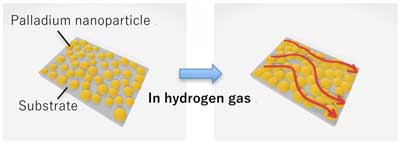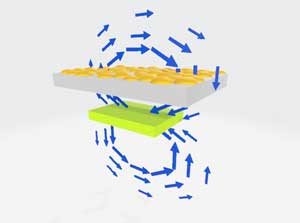| May 22, 2019 | |
Good vibrations: Using piezoelectricity to ensure hydrogen sensor sensitivity(Nanowerk News) A team at Osaka University has invented a new process for creating high-precision sensing devices that respond to the presence of hydrogen gas. By carefully controlling the deposition of metallic nanoparticles on a silicon surface, the researchers were able to create a sensor that can detect low levels of hydrogen on the basis of changes in electrical current (Applied Physics Letters, "Precise control of hydrogen response of semicontinuous palladium film using piezoelectric resonance method"). |
|
| This research may have important benefits as part of a switch to hydrogen-based fuels, which could power the zero-emission cars of the future and help fight anthropogenic climate change. | |
| To fabricate a hydrogen sensor, the researchers deposited metallic palladium on a silicon substrate. The deposited palladium forms nanoparticles on the substrate, and they act like tiny islands that are excellent conductors of electricity, but, because they do not form a connected network, the current across the device is very small. | |
 |
|
| Schematic of hydrogen sensing using palladium nanoparticles. Without hydrogen present, the metallic palladium nanoparticles (orange dots) act as isolated islands, and electric current cannot flow easily across the device. In contrast, when the device is exposed to even a small amount of hydrogen, the hydrogen atoms can bridge the gaps between islands, creating a connected network that allows a large current to pass though (red lines). (Image: Osaka University) | |
| However, when hydrogen atoms are present, they are absorbed into the palladium nanoparticles, increasing volume of the nanoparticles, and then bridge the gaps between the islands. Eventually, a completely connected path is formed, and electrons can flow with much less resistance. In this way, even a tiny change in hydrogen concentration can lead to a massive increase in current, so the devices can be made very sensitive. | |
| A significant challenge the Osaka researchers had to overcome was precisely controlling the gaps between islands to deposit in the first place. If the deposition time was too short, gaps between the nanoparticles are too wide and they would not be bridged even when hydrogen was present. | |
| Conversely, if the deposition time was too long, the nanoparticles would form a connected network on their own, even before hydrogen was applied. To optimize the response of the sensor, the research team developed a novel method for monitoring and controlling the deposition of palladium called piezoelectric resonance. | |
| "Piezoelectric materials, such as a quartz crystal in a wristwatch, can vibrate at a very specific frequency in response to an applied voltage," senior author Dr. Hirotsugu Ogi explains. Here, a piece of piezoelectric lithium niobate was set to vibrate underneath the sample during the metallic nanoparticle deposition. The oscillating piezoelectric created an electric field around the sample, which in turn induced a current in the device that depended on the connectivity of the palladium network. | |
 |
|
| Illustration of how piezoelectric resonance can be used to evaluate the separation between the palladium particles during device fabrication. As palladium nanoparticles (yellow) are being added to the sample, the vibrating piezoelectric material (green rectangular parallelepiped) generates an alternating electric field (blue arrows) near the substrate (gray) surface, creating a current flow in deposited palladium (orange particles). This causes some of the vibrational energy of the piezoelectric material to be lost. The value of the energy loss is greatest when the palladium particles contact each other, so deposition can be stopped at the optimal nanoparticle concentration. (Image: Osaka University) | |
| Then, the attenuation of the oscillation changes depending on the connectivity. Therefore, by listening to the sound (measuring the attenuation) of the piezoelectric material, the connectivity can be monitored. | |
| "By optimizing the deposition time using the piezoelectric resonance method, the resulting hydrogen sensors were 12 times more sensitive than before," first author Dr. Nobutomo Nakamura says. "These devices may represent a step towards a cleaner energy future involving hydrogen." |
| Source: Osaka University | |
|
Subscribe to a free copy of one of our daily Nanowerk Newsletter Email Digests with a compilation of all of the day's news. |
